Numerical Simulation of Transient Combustion and the Acoustic Environment of Obstacle Vortex-Driven Flow
Abstract
:1. Introduction
2. Methodology
2.1. Numerical Method
2.2. Test Case Description
2.3. Boundary Conditions
2.4. Validation of Numerical Methodology
3. Result and Discussion
4. Conclusions
- Pressure oscillation amplitude peak inside the chamber is found to be 2 to 5 % of the mean pressure value for cases in which inlet mass flux disturbance frequency is far away from the acoustic mode of the combustion chamber.
- The amplitude of pressure oscillation up to 18% and 5% of mean pressure are evident at the first and second mode of forced oscillation frequencies whenever the inlet mass flux disturbance frequency is close to the chamber’s natural frequency.
- For a combustion chamber with obstacle vortex shedding, pressure oscillation always occurs at inlet mass flux disturbance frequency and does not move towards the chamber’s natural frequency.
- Simulation of transient combustion shows that if the combustion frequency is close to the chamber’s modal frequency, then its amplitude increases greatly and creates an acute acoustic environment which also results in fuel savings.
- To evade the harsh acoustic environment and to burn fuel disproportionately, the modification of the combustion process or chamber configuration represents an appropriate solution.
Author Contributions
Funding
Institutional Review Board Statement
Informed Consent Statement
Data Availability Statement
Conflicts of Interest
References
- Culick, F.E.; Kuentzmann, P. Unsteady Motions in Combustion Chambers for Propulsion Systems; NATO Research and Technology Organization Neuilly-Sur-Seine: Paris, France, 2006. [Google Scholar]
- Su, W.; Li, S.; Zhang, Q.; Li, J.; Ye, Q.; Wang, N. Influence of thermal inhibitor position and temperature on vortex-shedding-driven pressure oscillations. Chinese J. Aeronaut. 2013, 26, 544–553. [Google Scholar] [CrossRef] [Green Version]
- Wang, D.; Yang, Y.; Fan, W.; Li, X.; Gao, Y. Simulation of pressure oscillations in a combustion chamber under periodic inlet disturbances. Acta Astronaut. 2018, 152, 859–871. [Google Scholar] [CrossRef]
- Emelyanov, V.N.; Teterina, I.V.; Volkov, K.N.; Garkushev, A.U. Pressure oscillations and instability of working processes in the combustion chambers of solid rocket motors. Acta Astronaut. 2017, 135, 161–171. [Google Scholar] [CrossRef] [Green Version]
- Anthoine, J. Experimental and Numerical Study of Aeroacoustic Phenomena in Large Solid Propellant Boosters. Ph.D. Thesis, Université Libre de Bruxelles, Faculté des Sciences Appliquées, Brussels, Belgium, 2000. [Google Scholar]
- Wolf, P.; Balakrishnan, R.; Staffelbach, G.; Gicquel, L.Y.M.; Poinsot, T. Using les to study reacting flows and instabilities in annular combustion chambers. Flow Turbul. Combust. 2012, 88, 191–206. [Google Scholar] [CrossRef] [Green Version]
- Wang, Z.; Li, X.; Feng, Z.; Yang, Z. The role of precessing vortex core in two combustion regimes: Numerical simulation studies. J. Mech. Sci. Technol. 2019, 33, 433–446. [Google Scholar] [CrossRef]
- Hegde, U.; Reuter, D.; Zinn, B.; Daniel, B. Fluid mechanically coupled combustion instabilities in ramjet combustors. In Proceedings of the 25th AIAA Aerospace Sciences Meeting, Reno, NV, USA, 24–26 March 1987; p. 216. [Google Scholar]
- Zhao, D.; Lu, Z.; Zhao, H.; Li, X.Y.; Wang, B.; Liu, P. A review of active control approaches in stabilizing combustion systems in aerospace industry. Prog. Aerosp. Sci. 2018, 97, 35–60. [Google Scholar] [CrossRef]
- Flandro, G.; Jacobs, H. Vortex generated sound in cavities. In Proceedings of the Aeroacoustics Conference, Seattle, WA, USA, 15–17 October 1973; p. 1014. [Google Scholar]
- Chen, L.; Gao, Y.; Wang, D.; Zou, Q.; Zhang, S. Numerical simulation on acoustic mode and pressure-oscillation decay in finocyl- and axil-grain combustion chambers. Aerosp. Sci. Technol. 2020, 107, 106351. [Google Scholar] [CrossRef]
- Stella, F.; Paglia, F. Pressure oscillations in solid rocket motors: Numerical study. Aerosp. Sci. Technol. 2011, 15, 53–59. [Google Scholar] [CrossRef]
- Shu, P.; Sforzini, R.; Forster, W., Jr. Vortex shedding from solid rocket propellant inhibitors. In Proceedings of the 22nd Joint Propulsion Conference, Hunstville, AL, USA, 16–18 June 1986; p. 1418. [Google Scholar]
- Zhao, D.; Li, X.Y. A review of acoustic dampers applied to combustion chambers in aerospace industry. Prog. Aerosp. Sci. 2015, 74, 114–130. [Google Scholar] [CrossRef]
- Dotson, K.W.; Koshigoe, S.; Pace, K.K. Vortex shedding in a large solid rocket motor without inhibitors at the segment interfaces. J. Propuls. Power 1997, 13, 197–206. [Google Scholar] [CrossRef]
- Bernardini, M.; Cimini, M.; Stella, F.; Cavallini, E.; Di Mascio, A.; Neri, A.; Martelli, E. Large-eddy simulation of vortex shedding and pressure oscillations in solid rocket motors. AIAA J. 2020, 58, 5191–5201. [Google Scholar] [CrossRef]
- Anthoine, J.; Lema, M.R. Passive Control of Pressure Oscillations in Solid Rocket Motors: Cold-Flow Experiments. J. Propuls. Power 2009, 25, 792–800. [Google Scholar] [CrossRef]
- Wang, C.; Zhang, Y.; Li, Z.; Xu, A. Pressure fluctuation—vortex interaction in an ultra-low specific-speed centrifugal pump. J. Low Freq. Noise Vib. Act. Control. 2019, 38, 527–543. [Google Scholar] [CrossRef] [Green Version]
- Anthoine, J.; Buchlin, J. Effect of nozzle cavity on resonance in large SRM: Numerical simulations introduction. J. Propuls. Power 2003, 19, 374–384. [Google Scholar] [CrossRef]
- Jia, Y.; Wang, Y.; Zhang, Q.; Rong, H.; Liu, Y.; Xiao, B.; Guo, D.; Laghari, M.; Ruan, R. Gas-carrying enhances the combustion temperature of the biomass particles. Energy 2022, 239, 121956. [Google Scholar] [CrossRef]
- Saha, S.; Chakraborty, D. Computational fluid dynamics simulation of combustion instability in solid rocket motor: Implementation of pressure coupled response function. Def. Sci. J. 2016, 66, 216–221. [Google Scholar] [CrossRef] [Green Version]
- Zhang, Q.; Wang, N.F.; Li, J.W.; Su, W.X.; Zhang, Y. Effect of the head cavity on pressure oscillation suppression characteristics in large solid rocket motors. Sci. China Technol. Sci. 2015, 58, 1250–1262. [Google Scholar] [CrossRef]
- Katona, C.; Safta, C.; Frunzulica, F.; Goemasn, M. Numerical simulations of gaseous flames in combustion chamber applications. In Journal of Physics: Conference Series, Proceedings of the 9th International Conference on Mathematical Modeling in Physical Sciences (IC-MSQUARE), Tinos Island, Greece, 7–10 September 2020; IOP Publishing: Bristol, UK, 2021; Volume 1730, p. 012110. [Google Scholar]
- Constante-Amores, C.R.; Kahouadji, L.; Batchvarov, A.; Shin, S.; Chergui, J.; Juric, D.; Matar, O.K. Direct numerical simulations of transient turbulent jets: Vortex-interface interactions. J. Fluid Mech. 2021, 922, A6. [Google Scholar] [CrossRef]
- Malalasekera, W.; Versteeg, H.K. An Introduction to Computational Fluid Dynamics: The Finite Volume Method; Prentice Hall: Harlow, UK, 2007. [Google Scholar]


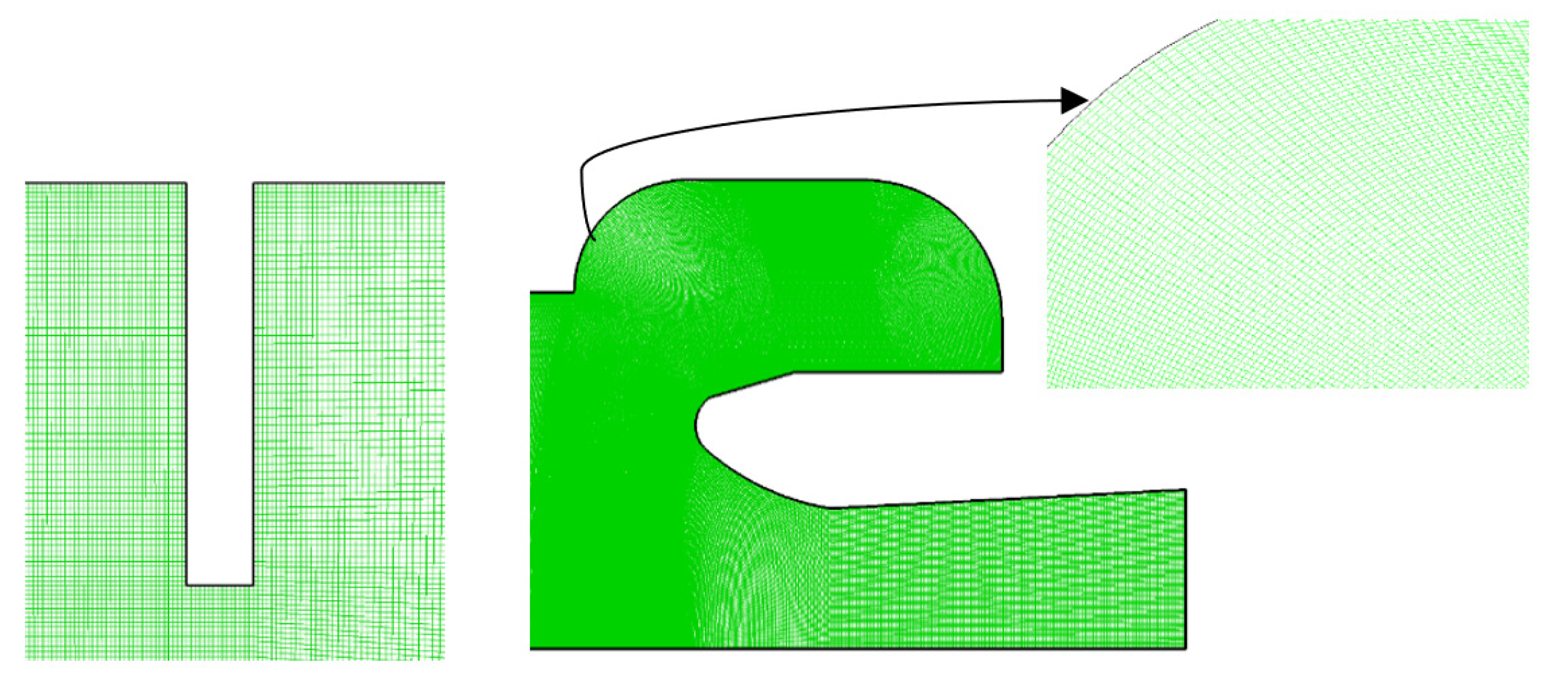
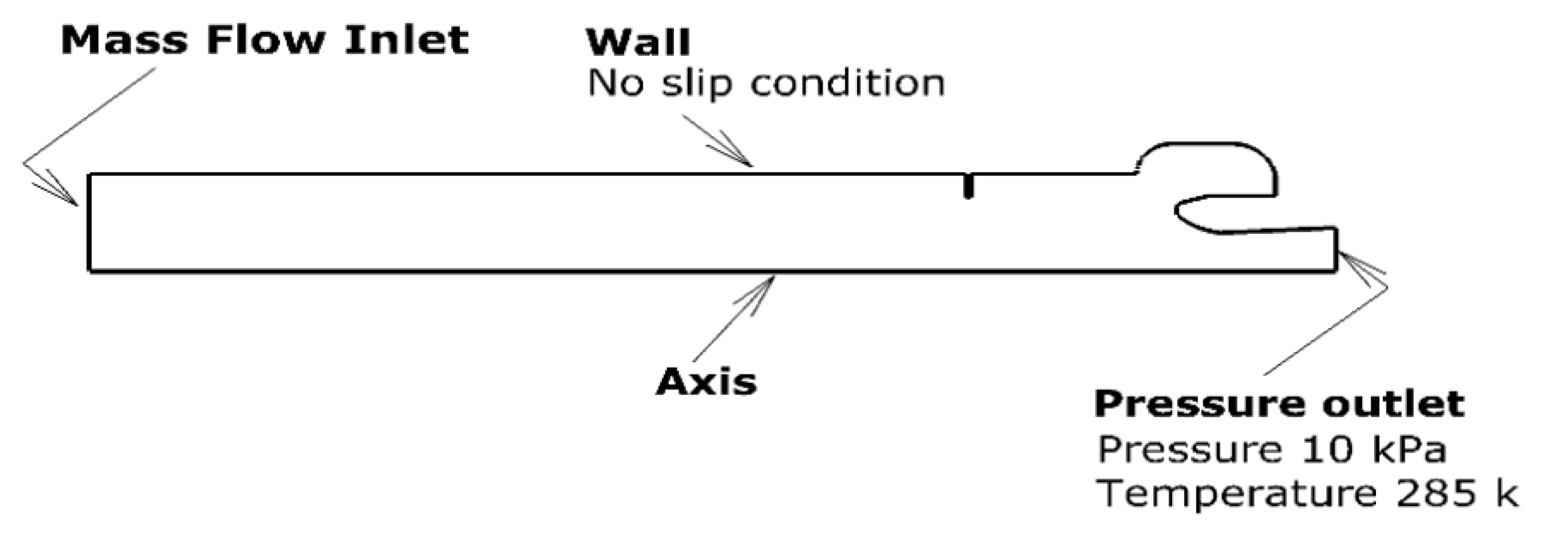

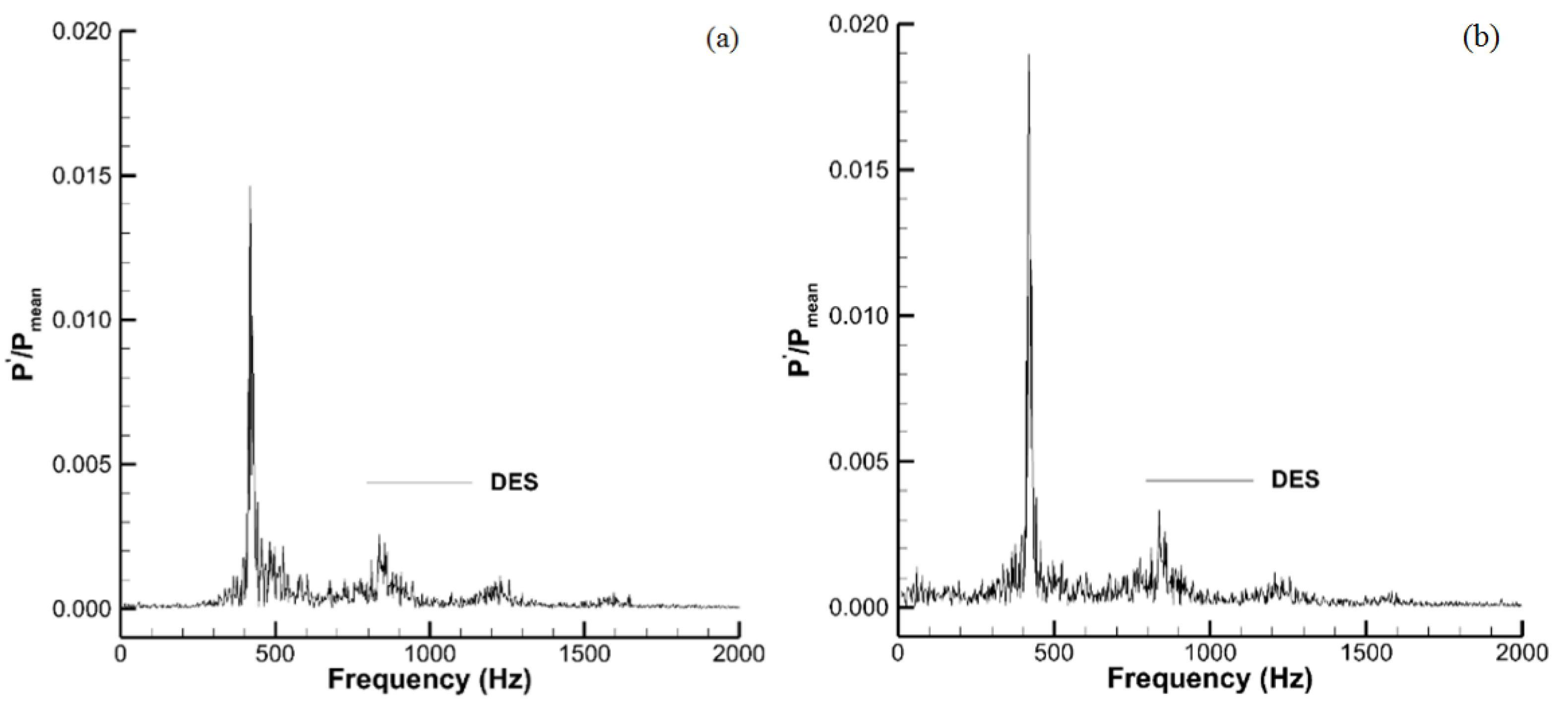
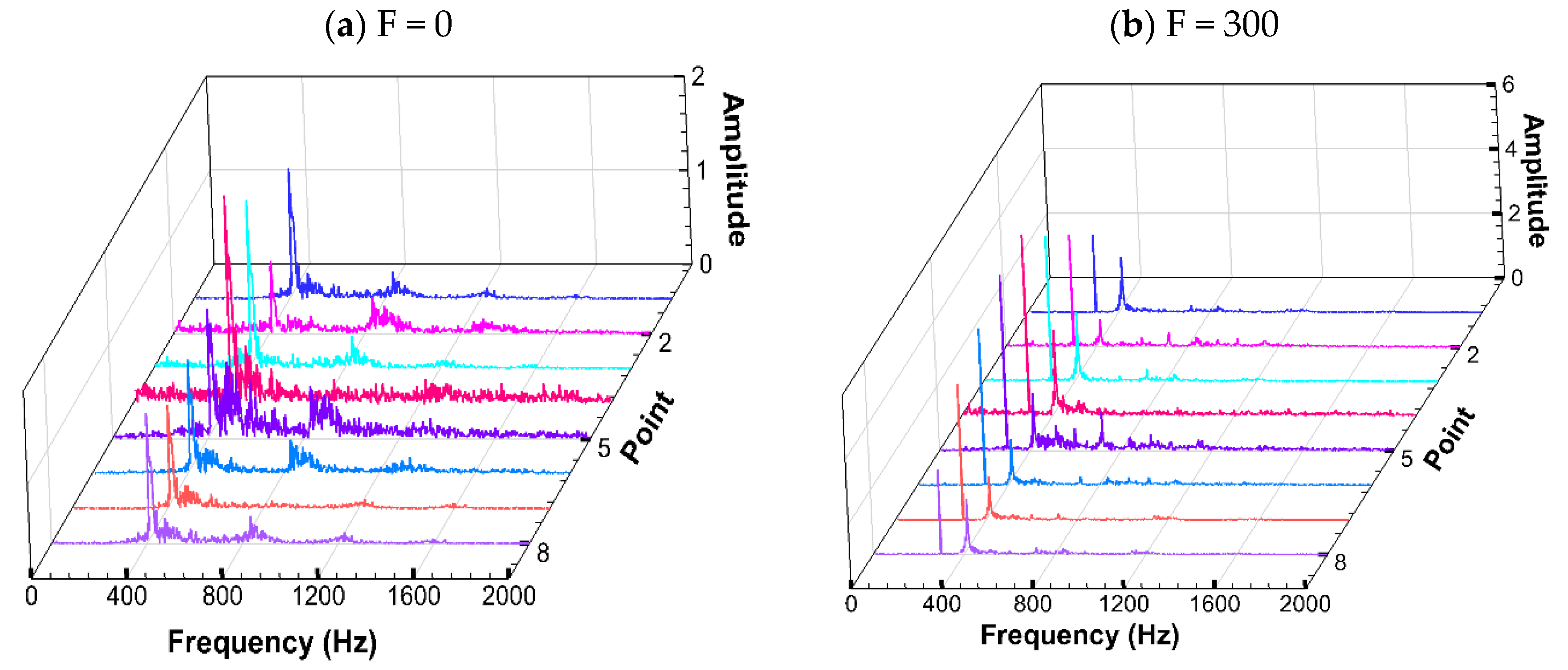
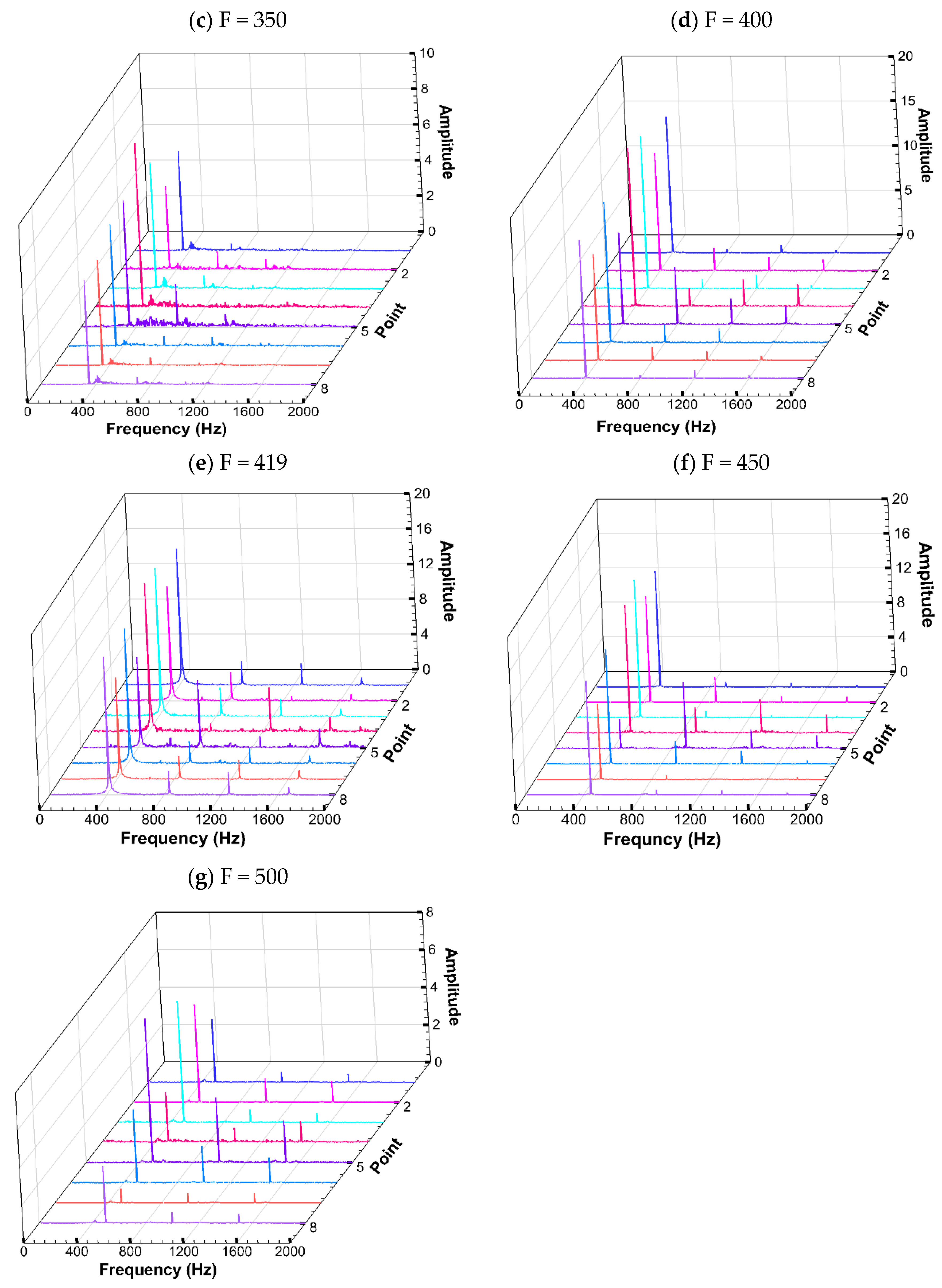
| Mode | Experimental | DES | |
|---|---|---|---|
| Point 1 | Point 3 | ||
| 1 | 408 | 412.6 | 412.6 |
| 2 | 874 | 837.2 | 837.2 |
| 3 | 1285 | 1228 | 1228 |
| 4 | 1744 | 1647 | 1647 |
| Frequency (HZ) | Location | |||||||
|---|---|---|---|---|---|---|---|---|
| 1 | 2 | 3 | 4 | 5 | 6 | 7 | 8 | |
| 0 | 1.3 | 0.78 | 1.8 | 2.2 | 1.3 | 1.2 | 1.1 | 1.3 |
| 300 | 2.4 | 3.5 | 4.5 | 5.6 | 5.4 | 4.8 | 4.2 | 2.6 |
| 350 | 5.5 | 4.6 | 7.0 | 9.2 | 7.0 | 6.8 | 5.9 | 5.8 |
| 400 | 15.2 | 13.2 | 17.1 | 17.8 | 10.2 | 15.7 | 11.8 | 15.5 |
| 419 | 15.5 | 13.0 | 16.8 | 16.9 | 10.3 | 15.3 | 11.6 | 15.7 |
| 450 | 13.4 | 12.2 | 15.9 | 14.8 | 3.4 | 13.3 | 8.7 | 13.2 |
| 500 | 3.3 | 5.2 | 6.4 | 2.6 | 7.6 | 3.8 | 0.76 | 3.0 |
Publisher’s Note: MDPI stays neutral with regard to jurisdictional claims in published maps and institutional affiliations. |
© 2022 by the authors. Licensee MDPI, Basel, Switzerland. This article is an open access article distributed under the terms and conditions of the Creative Commons Attribution (CC BY) license (https://creativecommons.org/licenses/by/4.0/).
Share and Cite
Bhutto, A.A.; Harijan, K.; Hussain, M.; Shah, S.F.; Kumar, L. Numerical Simulation of Transient Combustion and the Acoustic Environment of Obstacle Vortex-Driven Flow. Energies 2022, 15, 6079. https://doi.org/10.3390/en15166079
Bhutto AA, Harijan K, Hussain M, Shah SF, Kumar L. Numerical Simulation of Transient Combustion and the Acoustic Environment of Obstacle Vortex-Driven Flow. Energies. 2022; 15(16):6079. https://doi.org/10.3390/en15166079
Chicago/Turabian StyleBhutto, Afaque Ahmed, Khanji Harijan, Mukkarum Hussain, Syed Feroz Shah, and Laveet Kumar. 2022. "Numerical Simulation of Transient Combustion and the Acoustic Environment of Obstacle Vortex-Driven Flow" Energies 15, no. 16: 6079. https://doi.org/10.3390/en15166079






